Key Takeaways
Learn how to digitize plaque walls to create engaging digital recognition displays. Complete guide to modernizing traditional plaques, preserving institutional history, and creating interactive showcases.
Organizations face a common recognition crisis: decades of achievement plaques accumulate until display walls reach capacity, forcing impossible decisions about which accomplishments deserve visibility. Athletic departments, alumni associations, academic programs, and community organizations all struggle with the same fundamental limitation—physical plaque walls can only hold so many recognition plates before space runs out.
When you digitize plaque wall displays, you eliminate space constraints while simultaneously enhancing recognition value through searchable databases, multimedia content, and interactive exploration capabilities that traditional plaques simply cannot provide. Modern digital recognition systems honor every achievement without compromising quality or visibility, creating recognition programs that truly celebrate the full breadth of institutional excellence.
Why Organizations Choose to Digitize Plaque Walls
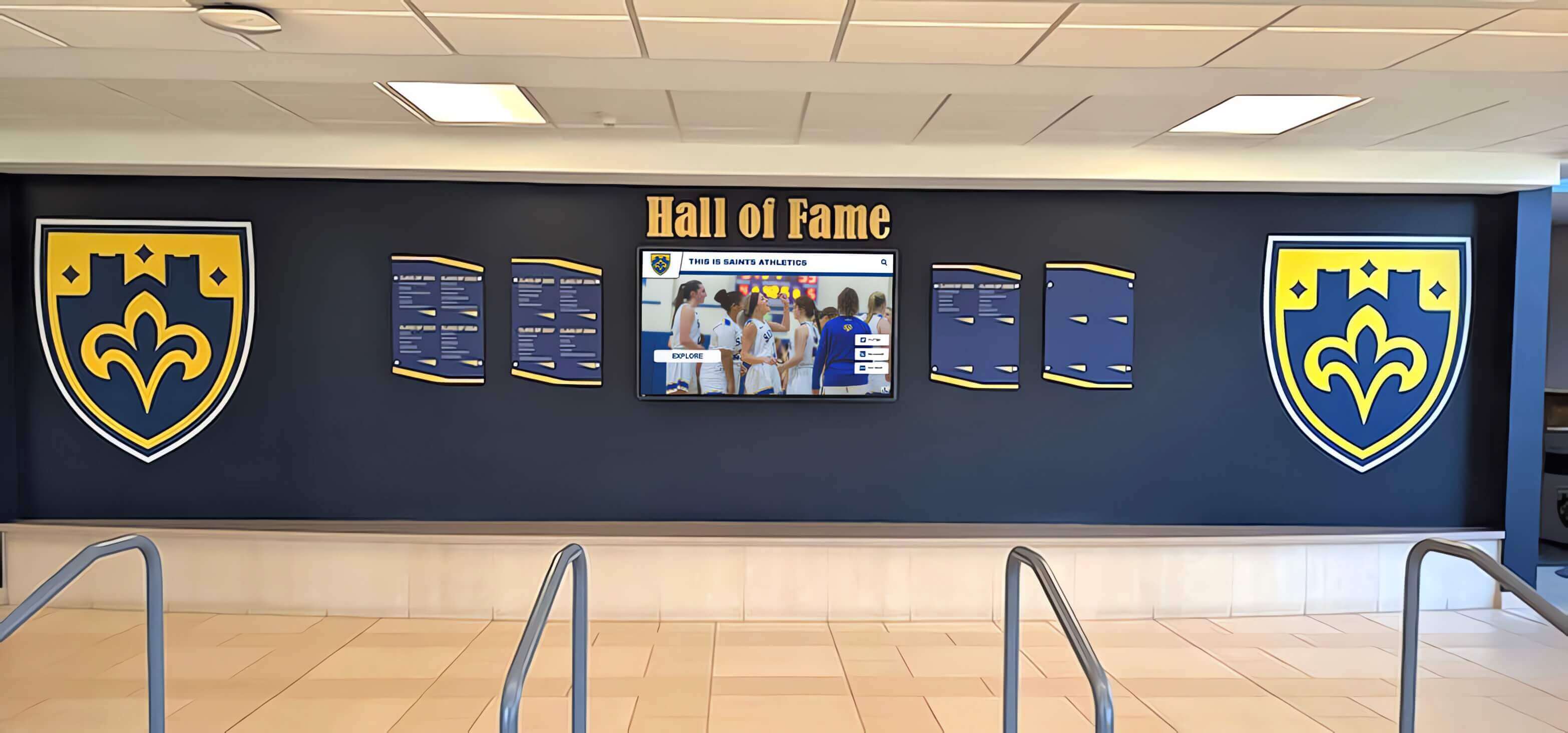
Before exploring the digitization process, understanding the compelling reasons organizations transition from traditional plaque walls to digital recognition helps build the case for modernization.
The Space Limitation Crisis
Traditional plaque walls face inherent capacity constraints that create increasingly difficult challenges over time. A typical recognition wall measuring 8 feet by 12 feet can accommodate approximately 80-120 standard recognition plaques before becoming overcrowded and illegible. For organizations with 50+ years of history, this capacity fills quickly.
Athletic programs commonly generate 15-30 new plaques annually across various sports, academic departments add 10-20 recognition plates for distinguished faculty and student achievements, and alumni associations honor 5-15 distinguished graduates each year. Even modest recognition programs accumulate 30-50 new plaques annually—meaning a typical plaque wall reaches capacity within just 2-3 years of initial installation.
When walls fill, organizations face three equally unsatisfying options: remove older plaques to make room for new ones (dishonoring past achievements), purchase additional plaque wall space (expensive and increasingly difficult to find appropriate locations), or simply stop adding new recognition (defeating the entire purpose of recognition programs).
Cost Considerations and Long-Term Value
The financial realities of traditional plaque walls often surprise organizations conducting total cost of ownership analyses. Individual engraved plaques typically cost $75-$300 each depending on materials, size, and complexity. Add professional installation fees of $25-$75 per plaque, and organizations spend $100-$375 for each new recognition addition.
Over 10 years, an organization recognizing 30 achievements annually invests $30,000-$112,500 just adding plaques to existing walls—not including the initial wall installation, periodic maintenance, re-engraving corrections, or eventual replacement when plaques tarnish or deteriorate.
When you digitize plaque wall systems, per-recognition costs drop dramatically. After initial platform setup, adding new recognition profiles costs only staff time for data entry and photography—typically 15-30 minutes per inductee. This efficiency creates substantial long-term savings while simultaneously enhancing recognition quality through rich multimedia profiles impossible with physical plaques.
Accessibility and Engagement Benefits
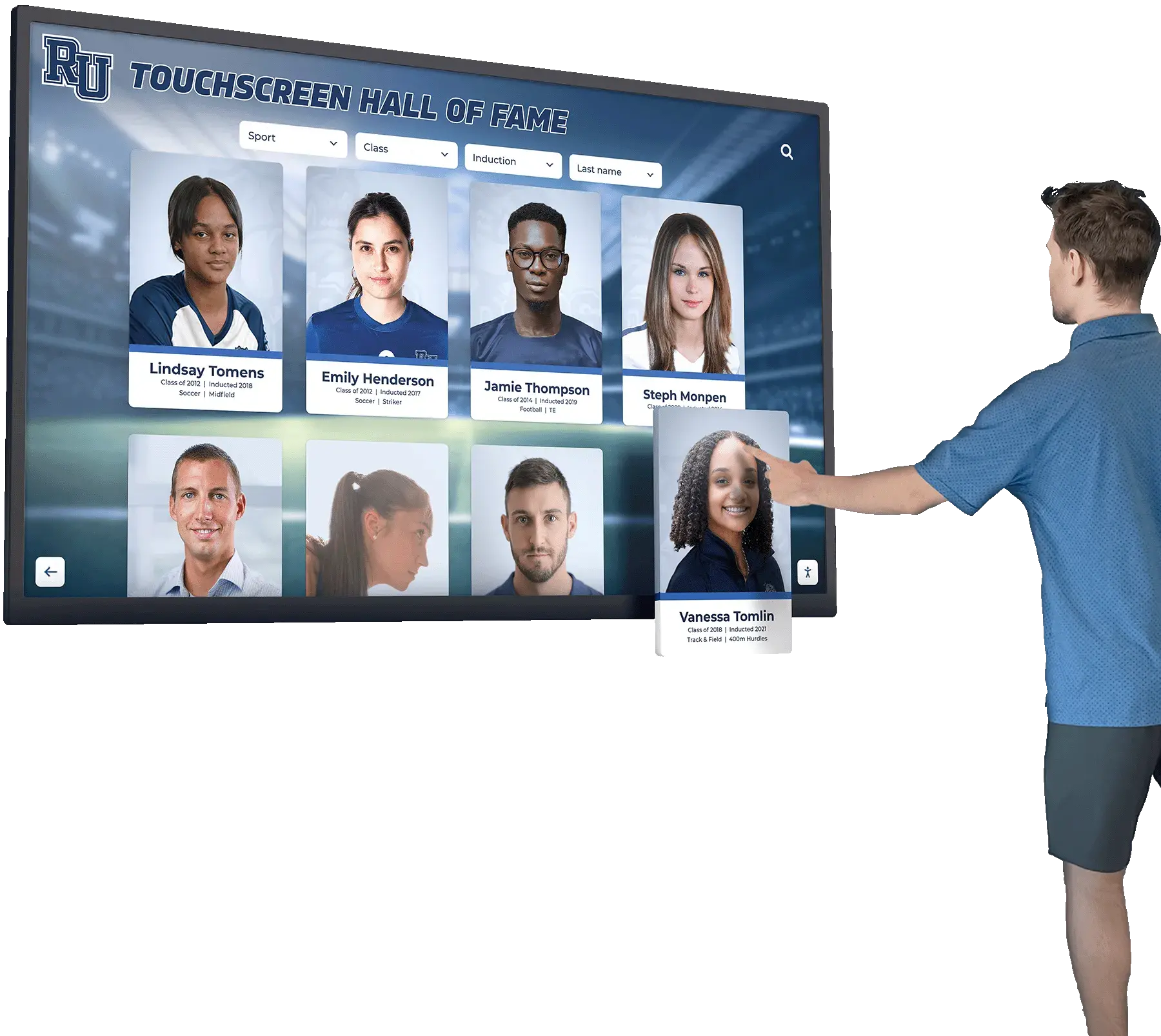
Physical plaque walls present significant accessibility barriers that digital systems eliminate:
Vision Limitations: Small engraved text requires close viewing and good eyesight, excluding individuals with vision impairments who cannot read detailed engravings even when physically present.
Physical Accessibility: Plaques mounted at standard heights create challenges for wheelchair users and children who cannot reach optimal viewing positions for upper portions of displays.
Geographic Constraints: Traditional plaques require physical presence to view, limiting recognition value to those who can visit in person and excluding distant alumni, remote community members, and geographically dispersed stakeholders.
Digital recognition displays address every limitation through adjustable text sizes, screen reader compatibility, remote web access enabling worldwide viewing, and searchable databases making specific achievements easily discoverable.
Solutions like digital record boards demonstrate how modern technology creates inclusive recognition experiences accessible to everyone regardless of physical ability or geographic location.
Understanding What Digitizing Plaque Walls Involves
When you digitize plaque wall displays, you’re not simply photographing plaques—you’re creating comprehensive digital archives that transform static recognition into engaging interactive experiences. The process involves several interconnected components working together to create modern recognition systems.
Documentation and Content Creation
Effective digitization begins with systematic documentation capturing every detail from existing plaque walls:
Physical Inventory: Photographing every plaque currently displayed or in storage, noting location, condition, and any issues like fading text or damaged materials.
Information Extraction: Recording all engraved text exactly as it appears, including names, dates, achievements, and any additional context plaques provide.
Historical Research: Gathering contextual information that enhances basic plaque details—biographical information about recipients, significance of achievements, related accomplishments, and stories that make recognition meaningful rather than just names and dates.
Visual Assets: Collecting photographs beyond just plaque images—recipient portraits, achievement photos, team pictures, event documentation, and other visual materials that enrich digital profiles.
Organizational Structure: Creating logical taxonomies enabling intuitive navigation—grouping by achievement type, time period, program area, or other relevant categories matching how users naturally explore content.
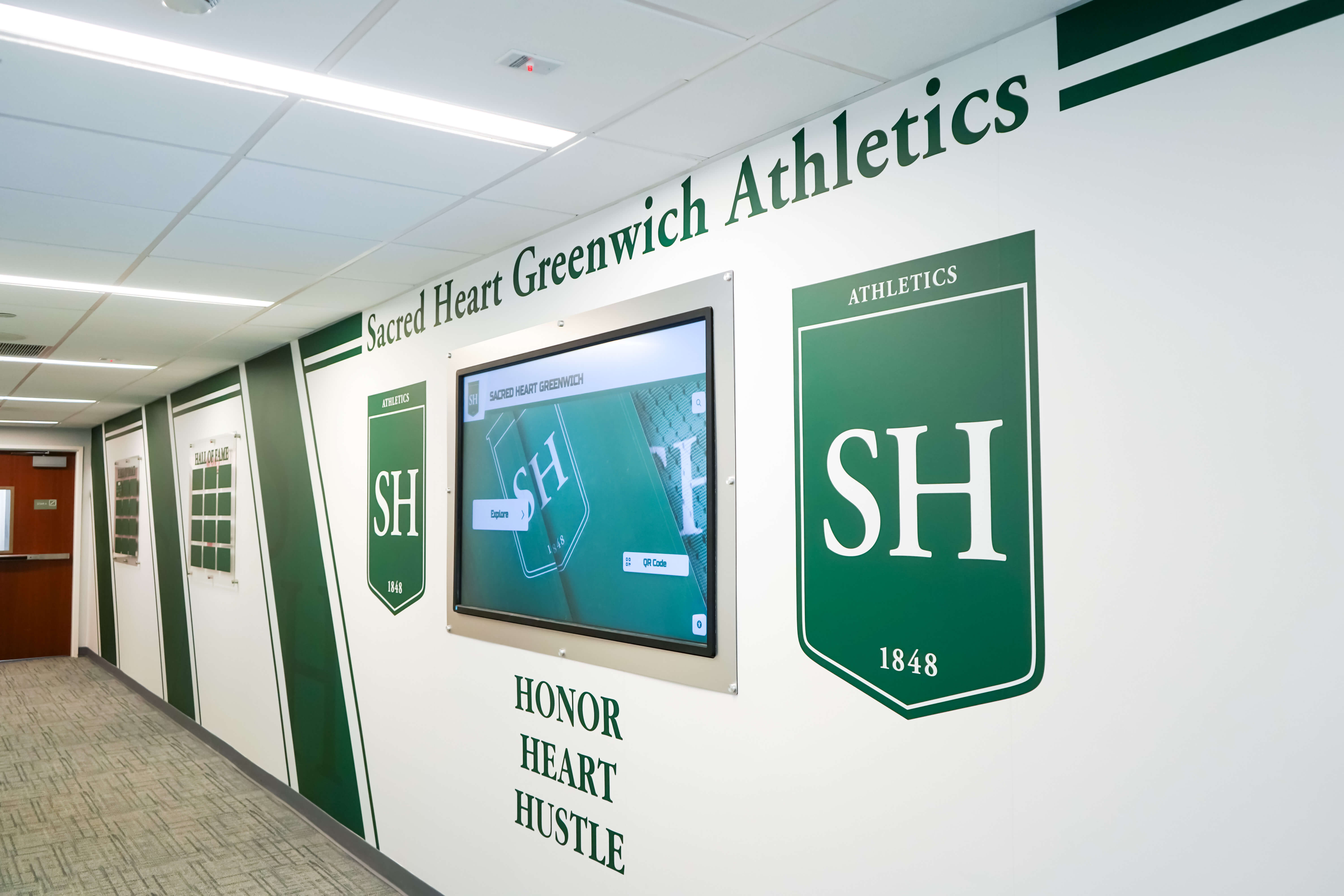
Technology Platform Selection
Choosing appropriate technology platforms determines both implementation success and long-term satisfaction with digitized recognition systems. Organizations typically select from three primary approaches:
Purpose-Built Recognition Platforms: Software specifically designed for institutional recognition offers pre-built frameworks, templates, and workflows optimized for halls of fame, plaque walls, and achievement recognition. These platforms provide user-friendly content management requiring minimal technical expertise, making them ideal for schools and organizations without dedicated IT staff.
Digital Signage Systems: Generic digital signage platforms offer flexibility for various content types but require more customization to function effectively for recognition programs. While potentially less expensive initially, these systems demand greater technical effort for setup and ongoing management.
Custom Development: Organizations with unique requirements and substantial budgets sometimes commission custom recognition platforms. This approach provides maximum flexibility but requires significant investment in development, testing, and ongoing maintenance.
For most schools and organizations, purpose-built digital recognition platforms offer the optimal balance of functionality, ease of use, and value—providing comprehensive recognition capabilities without requiring extensive technical resources.
Step-by-Step Process to Digitize Plaque Wall Displays
Successfully digitizing plaque walls requires systematic approaches ensuring comprehensive coverage, consistent quality, and effective implementation.
Step 1: Assess Your Current Recognition Program
Begin by thoroughly understanding what you currently have and what you hope to achieve through digitization:
Physical Assessment:
- Count total plaques currently displayed across all locations
- Measure existing wall space and physical constraints
- Document plaque conditions and maintenance needs
- Identify storage areas containing additional plaques not currently displayed
- Note any damaged, faded, or illegible plaques requiring attention
Program Evaluation:
- Review recognition criteria and selection processes
- Analyze achievement categories currently represented
- Identify gaps in recognition coverage or representation
- Evaluate update frequency and backlog of pending additions
- Assess stakeholder satisfaction with current recognition approaches
Technology Inventory:
- Document existing digital systems (websites, databases, etc.)
- Evaluate staff technical capabilities and training needs
- Assess network infrastructure and power availability at potential display locations
- Review IT policies affecting new system implementations
- Identify integration opportunities with existing platforms
This assessment phase typically takes 2-4 weeks for small organizations and 1-3 months for larger institutions with extensive recognition programs and multiple locations. The time invested ensures informed decision-making and prevents costly mistakes during implementation.
Step 2: Document and Photograph Existing Plaques
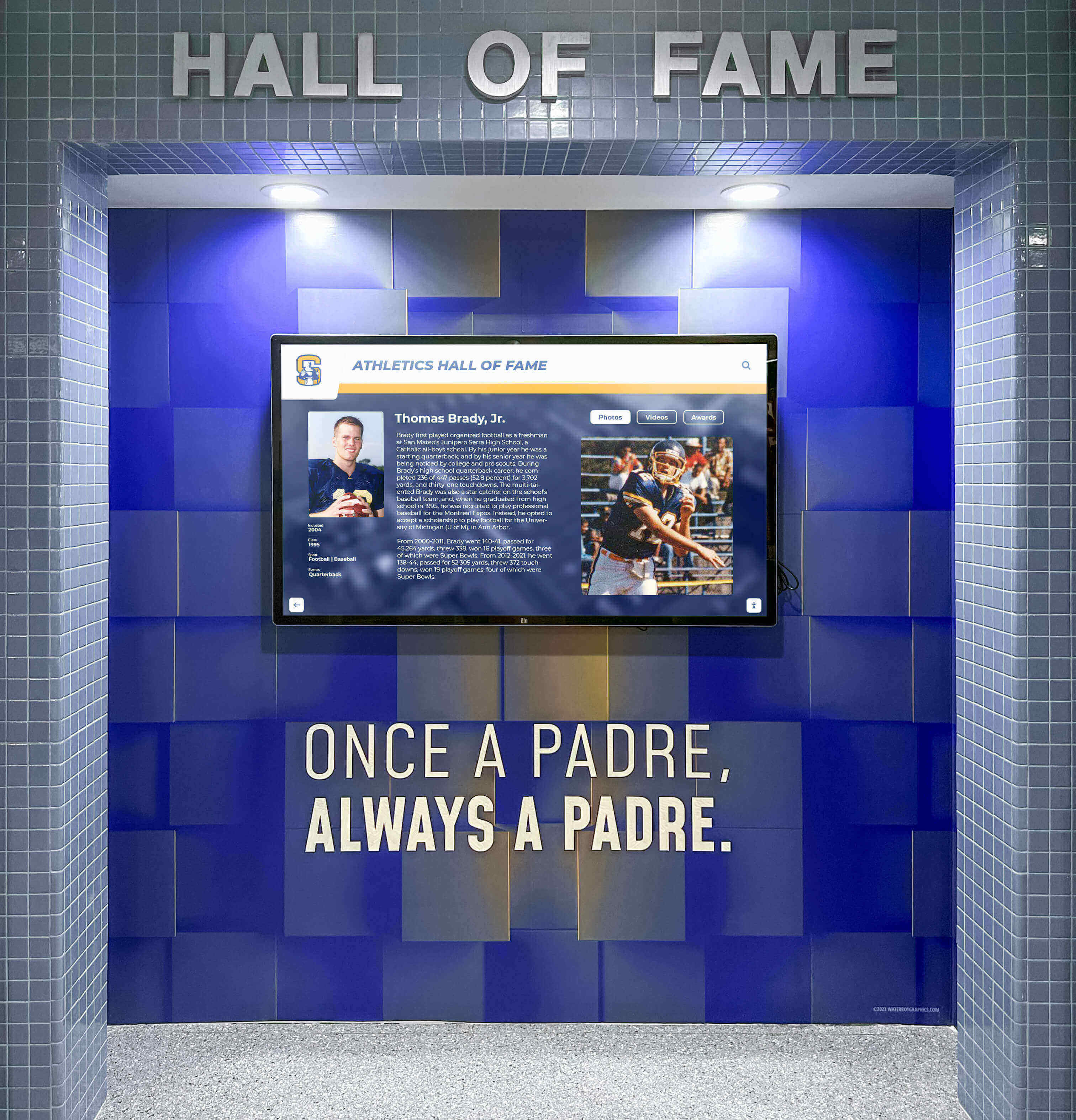
High-quality documentation forms the foundation of successful digitization projects. Systematic photography ensures comprehensive archives preserving existing recognition while creating assets for digital displays.
Photography Best Practices:
Equipment and Setup:
- Use high-resolution cameras (minimum 12 megapixels, preferably 20+ megapixels) ensuring text remains readable when zoomed
- Employ tripods or stable mounting ensuring sharp focus without motion blur
- Position plaques on neutral backgrounds eliminating visual distractions
- Implement consistent lighting preventing shadows, glare, or reflections obscuring text
- Shoot from straight-on angles avoiding distortion from oblique perspectives
Capture Requirements:
- Overall plaque image showing complete recognition in context
- Close-up shot focusing specifically on engraved text ensuring absolute clarity
- Detail shots capturing any decorative elements, logos, or special features
- Multiple exposures if necessary to handle challenging lighting or reflective surfaces
- Context photos showing plaques in their current wall locations before removal or relocation
Information Documentation:
While photographing plaques, simultaneously record structured data enabling searchable digital databases:
- Exact text as engraved (names, dates, achievements)
- Plaque dimensions and materials
- Original location if removing from walls
- Condition assessment notes
- Any corrections or additions identified through research
- Links to related recognitions or achievements
For organizations with hundreds of plaques, consider implementing digital asset management systems specifically designed for large-scale digitization projects, streamlining workflow and ensuring consistency across extensive collections.
Step 3: Research and Enrich Content
Photography captures what plaques display—but the most engaging digital recognition extends far beyond basic names and dates through comprehensive research and content enrichment.
Biographical Research:
Develop rich profiles that tell complete stories about individuals being recognized:
- Early life and educational background
- Career path and professional achievements
- Specific accomplishments leading to recognition
- Current activities and ongoing contributions
- Family connections and multi-generational relationships
- Advice or messages for current community members
- Personal stories and memorable moments
Achievement Context:
Help viewers understand significance rather than just noting facts:
- Explain what the achievement represents and why it matters
- Provide historical context showing how accomplishments compared to peers
- Detail obstacles overcome or challenges faced
- Describe lasting impact and legacy effects
- Connect recognition to broader institutional values or traditions
- Include statistics or records that quantify excellence
Source Materials:
Effective research draws from diverse sources:
- School yearbooks from relevant time periods
- Local newspaper archives and media coverage
- Alumni association records and databases
- Athletic record books and historical statistics
- Interview current interviews with recipients, family, teammates, colleagues
- Historical photographs and video footage
- Official institutional archives and documentation
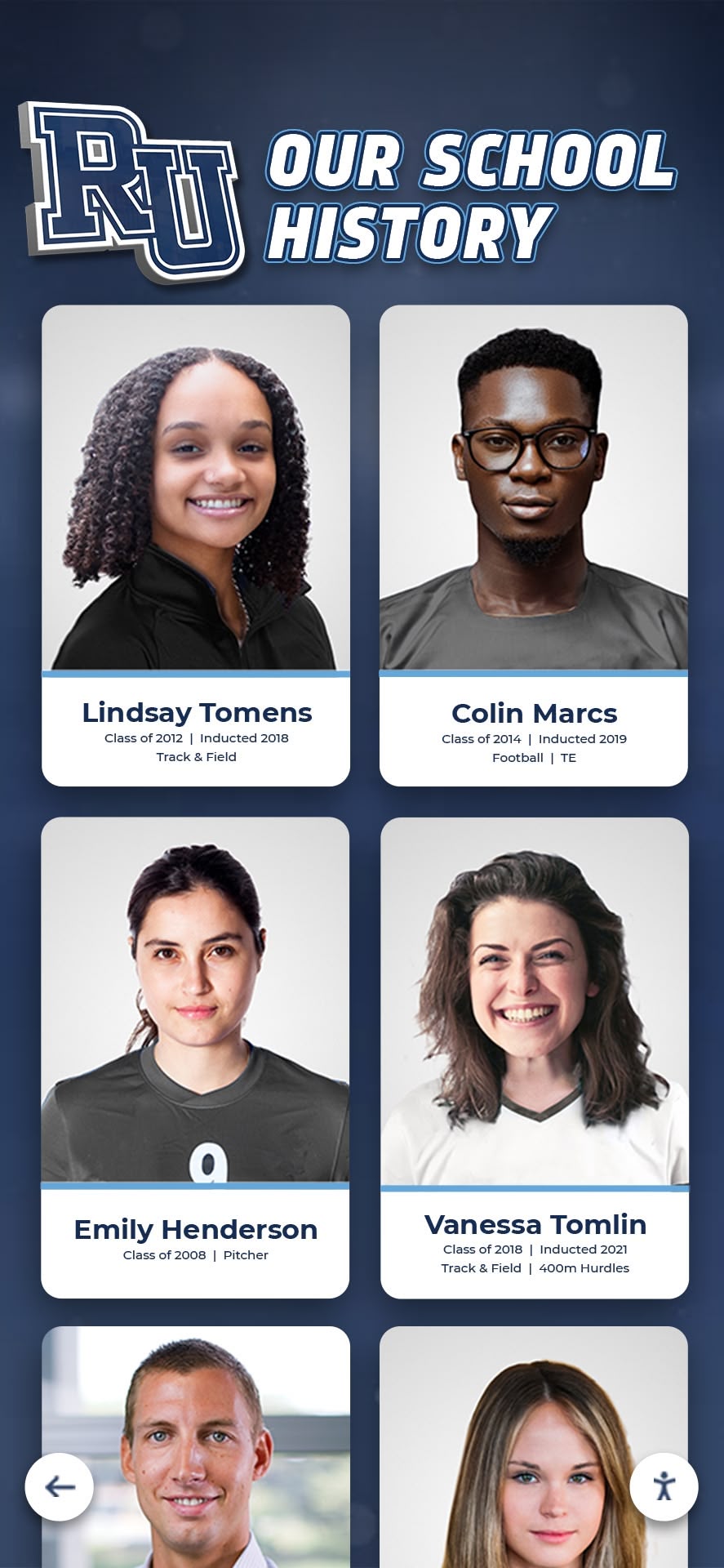
Organizations implementing community honors displays demonstrate how enriched content transforms simple recognition lists into compelling narratives that inspire viewers and honor recipients appropriately.
Step 4: Select and Implement Digital Display Technology
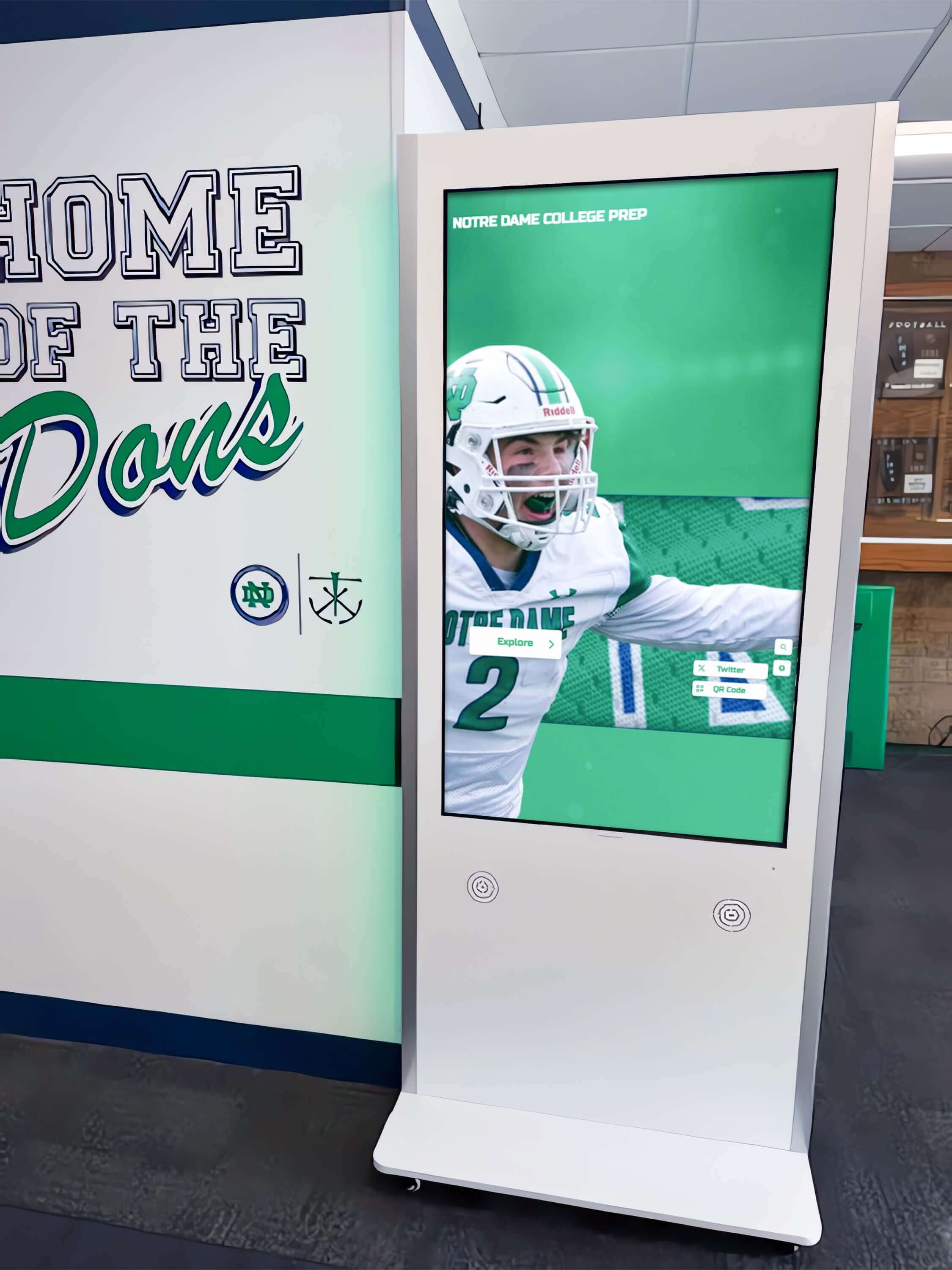
Choosing and implementing the right technology determines long-term success and stakeholder satisfaction with digitized plaque walls.
Hardware Considerations:
Interactive Touchscreen Displays:
- Commercial-grade touchscreens sized 43"-75" provide optimal visibility for high-traffic areas
- Consider both wall-mounted and freestanding kiosk configurations depending on space constraints
- Ensure commercial display ratings (typically 16-18 hours daily operation) rather than consumer TVs
- Plan for ADA-compliant mounting heights and wheelchair-accessible positioning
- Verify adequate ventilation and cooling for equipment longevity
Digital Signage Displays:
- Non-interactive displays cost less but sacrifice user exploration capabilities
- Ideal for secondary locations or supplementary displays beyond primary interactive installations
- Rotating content automatically showcases recognition without requiring user interaction
- Consider video wall configurations for high-impact visual statements in large spaces
Software Platform Features:
When evaluating recognition software, prioritize capabilities directly impacting user experience and administrative efficiency:
- Content Management: Intuitive interfaces allowing non-technical staff to add recognition profiles, update information, and upload media without IT assistance
- Search and Discovery: Powerful search enabling visitors to find specific individuals by name, year, achievement type, or keywords
- Multimedia Support: Capability to incorporate photos, videos, documents, and audio content creating rich recognition experiences
- Responsive Design: Automatic adaptation to different screen sizes enabling web access on desktop computers, tablets, and smartphones
- Analytics Dashboard: Usage tracking showing engagement patterns, popular content, and visitor behavior informing continuous improvement
- Cloud Architecture: Remote access for content updates from any location without requiring physical access to display hardware
Modern touchscreen software solutions provide comprehensive feature sets specifically designed for recognition programs, eliminating the complexity of custom development while ensuring professional presentation.
Step 5: Organize and Upload Content
Systematic content organization ensures intuitive navigation and positive user experiences with digitized plaque walls.
Organizational Frameworks:
Chronological Organization
Grouping recognition by decade, year, or induction period enables timeline-based exploration showing institutional evolution and achievement progression over time
Category-Based Structure
Organizing by achievement type (athletics, academics, service, alumni, etc.) helps visitors explore specific areas of excellence matching their interests
Alphabetical Listing
Simple A-Z organization enables quick access when visitors know specific names they're seeking, ideal for family members and alumni searching for relatives
Featured Collections
Curated groupings highlighting special themes, anniversaries, reunions, or seasonal content keep displays fresh and encourage repeat engagement
Most effective digital recognition systems support multiple simultaneous organizational approaches, allowing visitors to navigate via whichever method matches their current exploration goals.
Content Upload Workflow:
Implement efficient processes for transitioning documented plaques into live digital profiles:
- Data Entry: Input structured information into content management system using consistent formatting and complete all required fields
- Media Upload: Add all photographs, documents, videos, and other media files with descriptive filenames and metadata tags
- Profile Creation: Build complete recognition profiles incorporating biographical information, achievement details, and contextual narratives
- Quality Review: Carefully proofread all content checking for accuracy, completeness, grammar, and appropriate tone
- Relationship Linking: Connect related profiles (teammates, family members, mentors, program connections) enabling discovery through association
- Publication: Move approved profiles from draft status to published visibility, making content accessible to viewers
For organizations with extensive plaque collections, consider phased implementation prioritizing recent recognition first for immediate visibility, then systematically working backward through historical plaques over subsequent months to manage workload while delivering quick value.
Creating Engaging Interactive Experiences
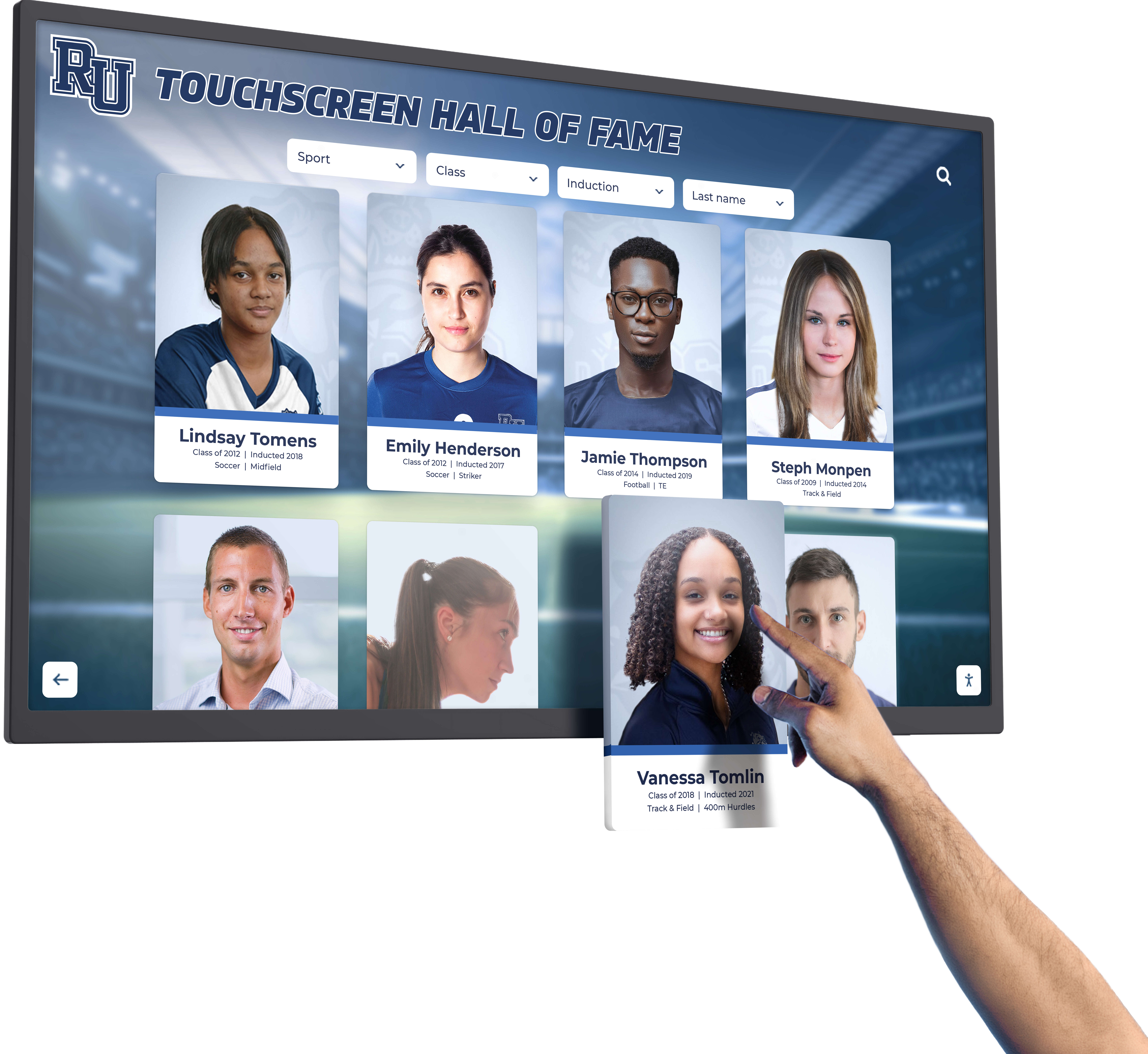
When you digitize plaque wall displays, you gain opportunities to create rich interactive experiences impossible with traditional static plaques.
Search and Discovery Features
Powerful search functionality transforms frustration into satisfaction by helping visitors quickly find specific recognition they’re seeking:
Name Search: Auto-complete suggestions as users type help correct spelling variations and quickly surface matching results even from large databases containing thousands of individuals.
Year Filtering: Drop-down year selectors or timeline scrubbers enable browsing recognition by specific time periods, ideal for reunion attendees exploring their graduation years or historical researchers examining specific eras.
Achievement Filtering: Category checkboxes allow visitors to narrow results by program area (athletics, academics, service, etc.), sport or activity type, or recognition level (local, state, national).
Keyword Search: Full-text search across all content fields finds relevant recognition even when visitors don’t know specific names—searching “football quarterback” or “Fulbright scholarship” surfaces matching achievements.
Random Discovery: “Surprise me” or “explore random” features encourage serendipitous discovery, particularly engaging for students and visitors who enjoy browsing without specific goals in mind.
Multimedia Storytelling Capabilities
Digital platforms enable rich content experiences that make recognition meaningful and memorable:
Video Integration: Welcome messages from organizational leaders, video interviews with inductees reflecting on achievements and sharing advice, highlight reels from championship seasons or significant events, and acceptance speeches from induction ceremonies create emotional connections impossible with text alone.
Photo Galleries: Multiple images showing individuals at different life stages, achievement documentation photographs, team or group pictures, and historical images provide visual richness that single engraved plaques cannot match.
Document Display: Newspaper articles about achievements, award certificates and official recognition documentation, published research or creative works, and letters of recommendation or nomination materials provide authentication and additional context.
Audio Content: Voice recordings from inductees, podcast interviews exploring careers and life stories, and oral history archives preserve authentic voices and perspectives.
Organizations exploring digital class composites and similar programs demonstrate how multimedia content creates engaging recognition experiences that visitors remember long after viewing.
Social Sharing and Remote Access
Modern digital recognition extends beyond physical locations through web integration and social connectivity:
Web Accessibility: Online recognition galleries enable alumni and community members to explore achievements from anywhere globally, dramatically extending recognition reach beyond those who can physically visit.
Social Media Integration: One-touch sharing buttons allow visitors to post specific recognition profiles to Facebook, Twitter, LinkedIn, or email, amplifying visibility through personal networks.
Mobile Optimization: Responsive designs automatically adapt to smartphones and tablets, enabling mobile exploration during campus visits or remote viewing on any device.
QR Code Linking: Physical QR codes placed near displays enable smartphone users to instantly access extended online content including video interviews, photo galleries, and detailed biographies.
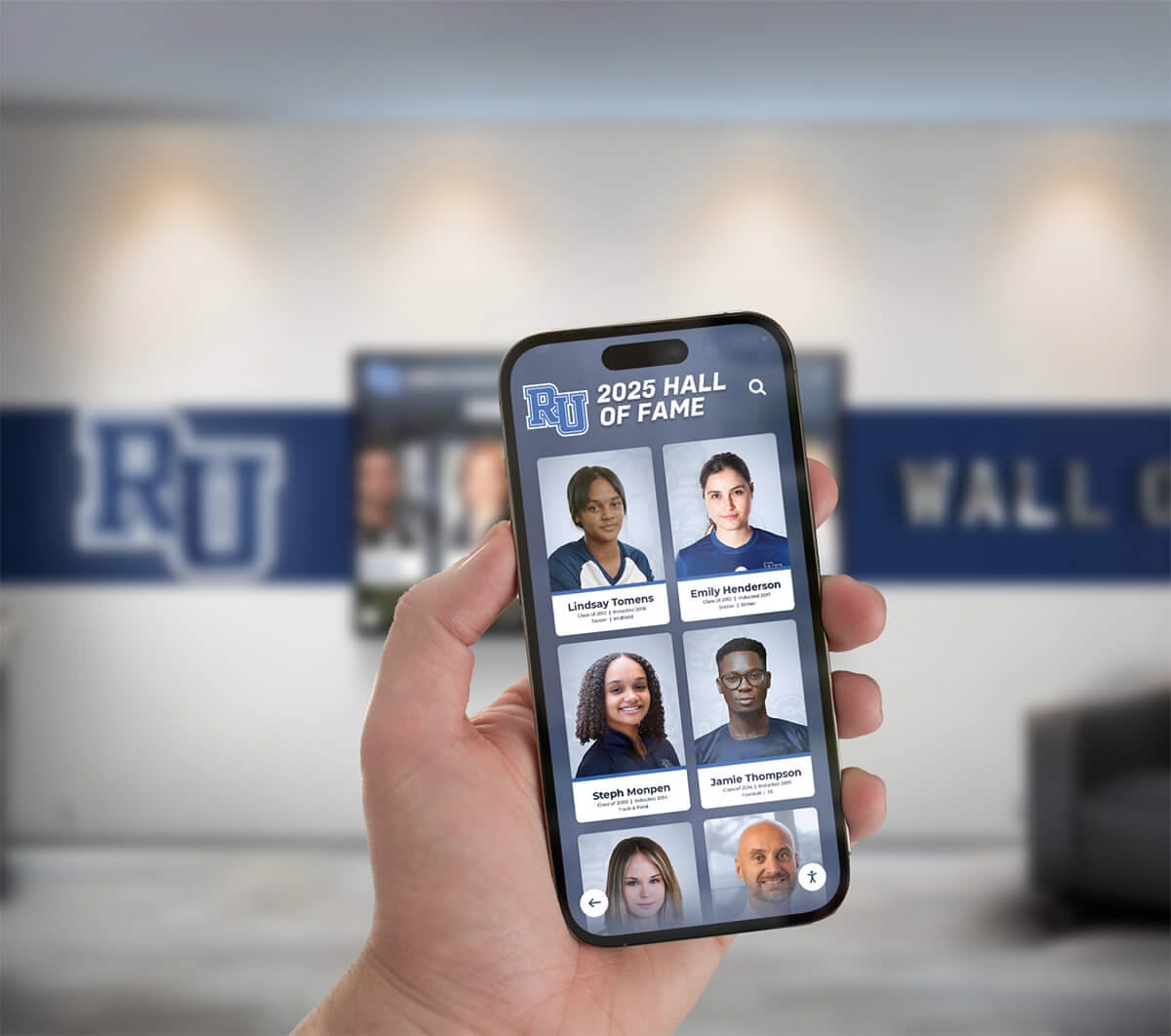
These connectivity features transform local recognition into global visibility, particularly valuable for engaging distant alumni and distributed communities.
Implementation Best Practices and Common Challenges
Organizations successfully digitizing plaque walls follow proven approaches addressing predictable challenges systematically.
Phased Implementation Strategies
Rather than attempting complete digitization simultaneously, phased approaches deliver value faster while managing resource constraints:
Phase 1: Recent Recognition (Months 1-3)
- Focus on recognition from the past 5-10 years
- Typically involves 50-200 plaques for most organizations
- Creates immediate visible value demonstrating system capabilities
- Generates excitement and stakeholder buy-in for continued effort
- Provides learning experiences refining processes before tackling more complex historical content
Phase 2: Modern Era (Months 4-6)
- Extend coverage backward 20-30 years
- Usually involves 200-500 additional plaques
- Fills out substantial majority of recent institutional history
- May include living inductees who can contribute interviews and additional content
- Builds comprehensive coverage most relevant to current community members
Phase 3: Historical Archives (Months 7-12)
- Complete digitization of remaining historical recognition
- May involve 500-1,000+ older plaques depending on institutional age
- Requires more extensive research as documented information becomes scarcer
- Preserves institutional memory before living knowledge disappears
- Demonstrates comprehensive respect for all achievements across entire history
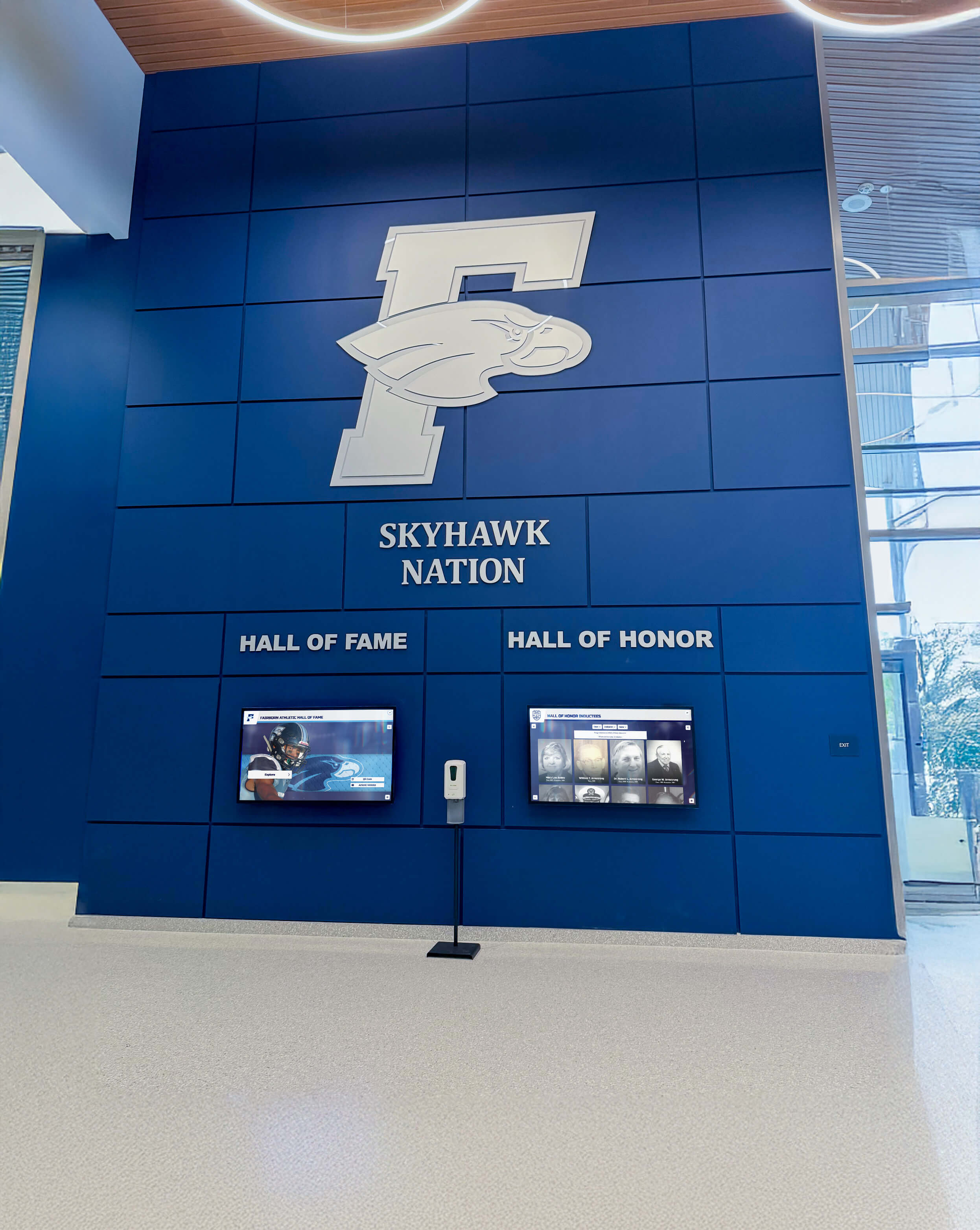
This phased approach allows organizations to demonstrate success, learn from experience, and secure additional resources based on proven value rather than requesting full funding upfront based only on projections.
Addressing Missing Information
Older plaques often lack complete information, with worn engravings, lost context, or simply minimal original details. Systematic research approaches help fill gaps:
Historical Records Review:
- Consult institutional yearbooks from relevant years for photos, rosters, and achievement documentation
- Search newspaper archives through online databases or local library microfilm collections
- Review official athletic or academic record books maintained by programs
- Examine board meeting minutes and official institutional records in archives
- Check with state or national associations that may have competition records
Human Knowledge Capture:
- Interview longtime staff members, coaches, or administrators who remember historical periods
- Contact alumni from relevant eras who can provide first-hand accounts and context
- Reach out to family members of deceased inductees who may have preserved materials
- Consult historical societies or local historians familiar with institutional history
- Engage retired employees who maintained past recognition programs
Handling Uncertainty:
When definitive information cannot be verified despite research efforts, maintain integrity by acknowledging uncertainty rather than guessing: “Believed to be state championship from 1972 based on plaque style and uniform details visible in photograph” is far preferable to confidently stating incorrect information that undermines credibility.
Organizations can reference guides about preserving school history for additional strategies addressing historical documentation challenges.
Budget Planning and Resource Allocation
Understanding realistic costs enables appropriate budget planning and resource allocation for digitization projects:
Initial Investment Components:
Hardware Costs:
- Commercial touchscreen display: $3,000-$8,000 depending on size and features
- Mounting hardware and installation: $500-$1,500
- Computer module (if not integrated): $500-$1,200
- Network infrastructure upgrades if needed: $500-$2,000
Software Costs:
- Recognition platform setup and configuration: $2,000-$5,000
- Annual software licensing: $1,500-$4,000
- Initial training and support: $500-$1,500
Content Development:
- Photography and documentation (if outsourcing): $2,000-$5,000
- Historical research and writing: $3,000-$8,000
- Initial content entry: $2,000-$6,000
Total Initial Investment Range: $10,000-$35,000 for complete implementation including hardware, software, and comprehensive content development. Organizations implementing multiple displays or requiring extensive historical research may invest $50,000-$100,000 for comprehensive multi-location systems.
Ongoing Costs:
- Annual software licensing: $1,500-$4,000
- Occasional hardware maintenance or replacement: $200-$500 annually
- Staff time for updates and additions: 2-5 hours monthly
- Periodic content refreshes and enhancements: $500-$2,000 annually
When comparing these costs to traditional plaque walls requiring $100-$375 per new recognition addition, digital systems typically achieve payback within 2-4 years even before considering enhanced functionality and accessibility benefits.
Measuring Success and Maximizing Impact
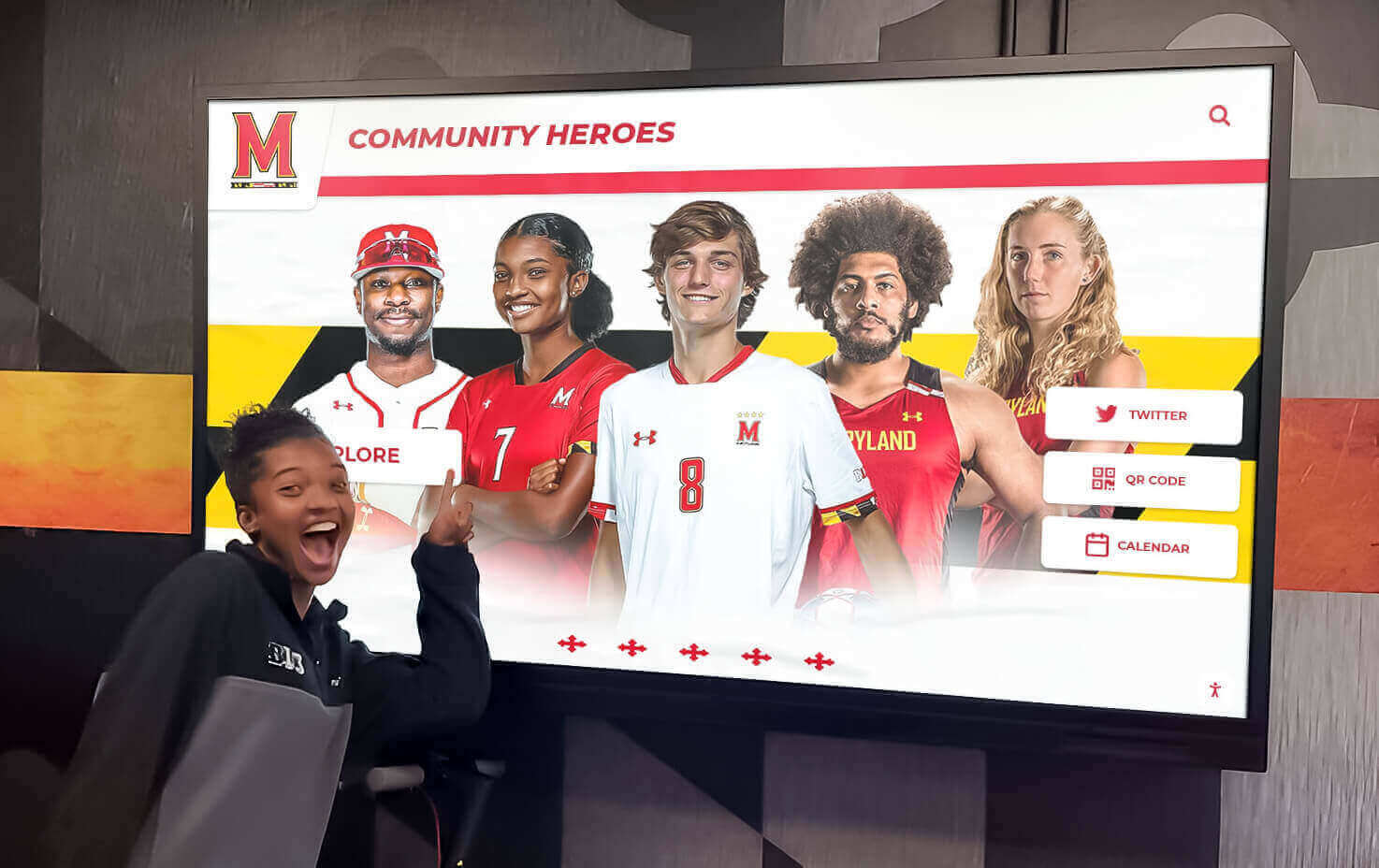
Effective digitized plaque walls include measurement strategies demonstrating value and informing ongoing optimization.
Engagement Metrics and Analytics
Digital recognition platforms provide data visibility impossible with traditional plaque walls:
Usage Statistics:
- Total visitor interactions and average session lengths showing overall engagement levels
- Most popular recognition profiles revealing which individuals or achievements resonate strongest
- Search terms and filters used indicating how visitors explore content
- Peak usage times identifying when displays receive greatest attention
- Return visitor rates demonstrating sustained interest rather than one-time curiosity
Content Performance:
- Video completion rates showing which multimedia content maintains viewer attention
- Photo gallery interaction measuring how thoroughly visitors explore visual materials
- Profile depth metrics revealing whether users read complete biographies or only scan headlines
- Social sharing frequency indicating which recognition generates word-of-mouth amplification
- Related content clicks showing how effectively linked profiles encourage expanded exploration
Technical Health:
- System uptime and reliability tracking
- Content management system usage showing update frequency
- Error logs identifying any technical issues requiring attention
- Performance metrics ensuring responsive user experiences
These analytics enable data-driven decisions about featured content, navigation optimization, and content development priorities rather than relying on assumptions about what visitors want.
Stakeholder Satisfaction Assessment
Quantitative metrics provide important insights, but qualitative feedback reveals impact in ways numbers alone cannot:
Student Perspectives:
- Do students regularly interact with displays during passing periods and free time?
- Can they articulate how recognition content connects to their own goals and aspirations?
- Do they mention displays when giving tours to prospective students or families?
- What additional content or features would increase student engagement?
Alumni Reactions:
- Can alumni easily find their own recognition or that of classmates and family members?
- Do they share digital recognition content through social media or personal communications?
- Has recognition strengthened their emotional connection to the institution?
- Do they report positive experiences showing displays to family and friends during visits?
Staff Observations:
- How frequently do visitors engage with displays in locations where staff can observe?
- What conversations and reactions occur around recognition displays?
- Do prospective students and families explore displays during campus tours?
- What questions or feedback do visitors provide about recognition content or functionality?
Regular stakeholder surveys and informal conversations provide essential feedback complementing quantitative analytics, revealing opportunities for enhancement and demonstrating recognition value to leadership.
Continuous Improvement Practices
The most successful digitized plaque walls evolve continuously based on feedback and usage patterns:
Content Refresh Cycles: Rotate featured recognition highlighting seasonal themes, reunion years, anniversaries, or current connections to institutional events, keeping displays fresh even for frequent viewers.
Technology Updates: Implement software updates providing new features, security enhancements, and capability improvements ensuring platforms remain current with evolving technology.
Expansion Projects: Systematically add historical recognition not included in initial implementations, expanding coverage backward through institutional history toward comprehensive representation.
Multimedia Enhancement: Produce video interviews, photo galleries, and other rich content enriching existing profiles beyond initial text and single-image recognition.
Community Contribution: Develop processes allowing alumni and family members to submit additional content, corrections, or personal reflections enriching official recognition profiles.
Organizations committed to continuous improvement create recognition programs that compound value over years and decades rather than becoming static installations that gradually grow outdated.
Integrating Digital Recognition into Broader Programs
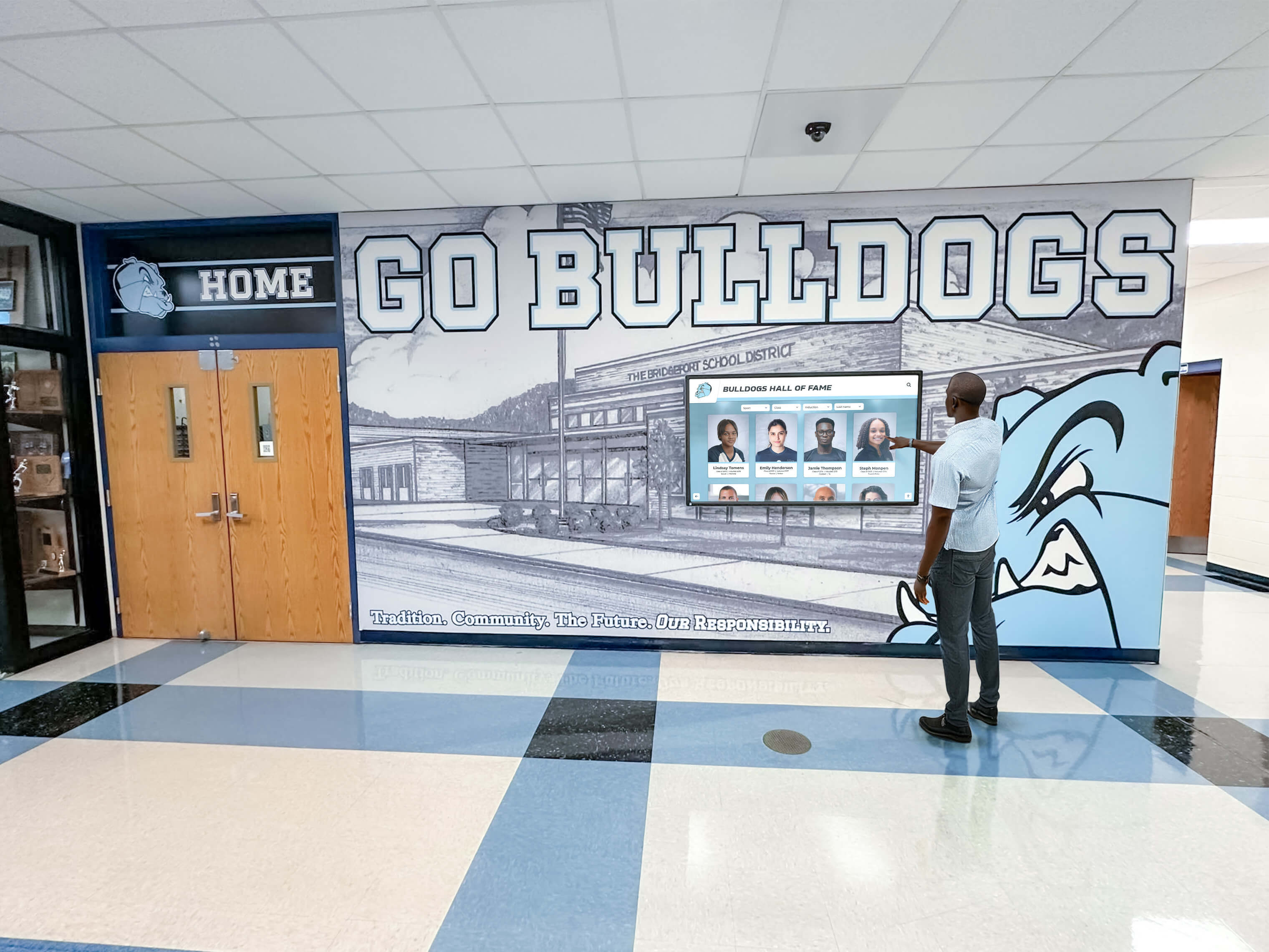
Digitized plaque walls function best as components of comprehensive recognition ecosystems rather than standalone projects.
Connecting Multiple Recognition Types
Modern digital platforms easily integrate diverse recognition categories that traditional separate plaque walls kept segregated:
Athletic Excellence: Championships, record-holders, distinguished athletes, and outstanding coaches showcased alongside other forms of achievement rather than isolated in athletic facilities.
Academic Achievement: Distinguished scholars, research accomplishments, teaching excellence awards, and intellectual contributions receive equal prominence demonstrating that institutions value diverse forms of excellence.
Arts and Performance: Music, theater, visual arts, and creative accomplishments highlighted appropriately for schools and organizations recognizing creative achievement alongside athletic and academic success.
Service and Leadership: Community service awards, volunteer leadership, civic contributions, and positive citizenship honored as legitimate excellence deserving recognition.
Alumni Distinction: Post-graduation achievements of former students showcased through systems like touchscreen hall of fame alumni recognition creating comprehensive legacy documentation.
This integrated approach communicates that institutions value all forms of excellence, helping students understand that multiple pathways to achievement exist and deserve celebration.
Alumni Engagement Integration
Digital recognition becomes powerful alumni engagement tool when integrated with broader relationship-building strategies:
Reunion Events: Feature curated content from class graduation years during reunion weekends through special digital displays and web galleries, sparking memories and conversations among returning alumni.
Fundraising Campaigns: Showcase how donor support enabled recognized achievements and programs, demonstrating philanthropic impact through tangible achievement recognition rather than abstract appeals.
Mentorship Programs: Connect current students with accomplished alumni through recognition profiles including opt-in contact information for networking and mentorship opportunities.
Update Submissions: Create processes allowing alumni to submit career updates, current photos, and “where are they now” information maintaining living connections rather than static historical records.
Social Amplification: Leverage alumni social networks by making recognition easily shareable, turning hundreds or thousands of alumni into recognition ambassadors broadcasting achievements to personal networks.
Schools implementing college recruitment digital recognition strategies demonstrate how recognition content supports multiple institutional goals beyond simple display.
Educational Integration Opportunities
Recognition content provides rich educational resources when thoughtfully integrated into curriculum and learning experiences:
History Lessons: Local history courses examine institutional evolution through achievement timelines showing how programs developed over decades.
Career Exploration: Alumni achievement profiles illustrate diverse career paths, helping students envision professional possibilities beyond familiar options.
Writing Assignments: Students research and write biographical profiles of recognized individuals, developing research and writing skills while contributing to recognition programs.
Speaking Opportunities: Invite recognized individuals to speak in classes or assemblies, creating direct connections between current students and accomplished alumni or community members.
Goal Setting: Teachers reference specific recognition profiles as examples when helping students set ambitious but achievable goals in academics, athletics, or other pursuits.
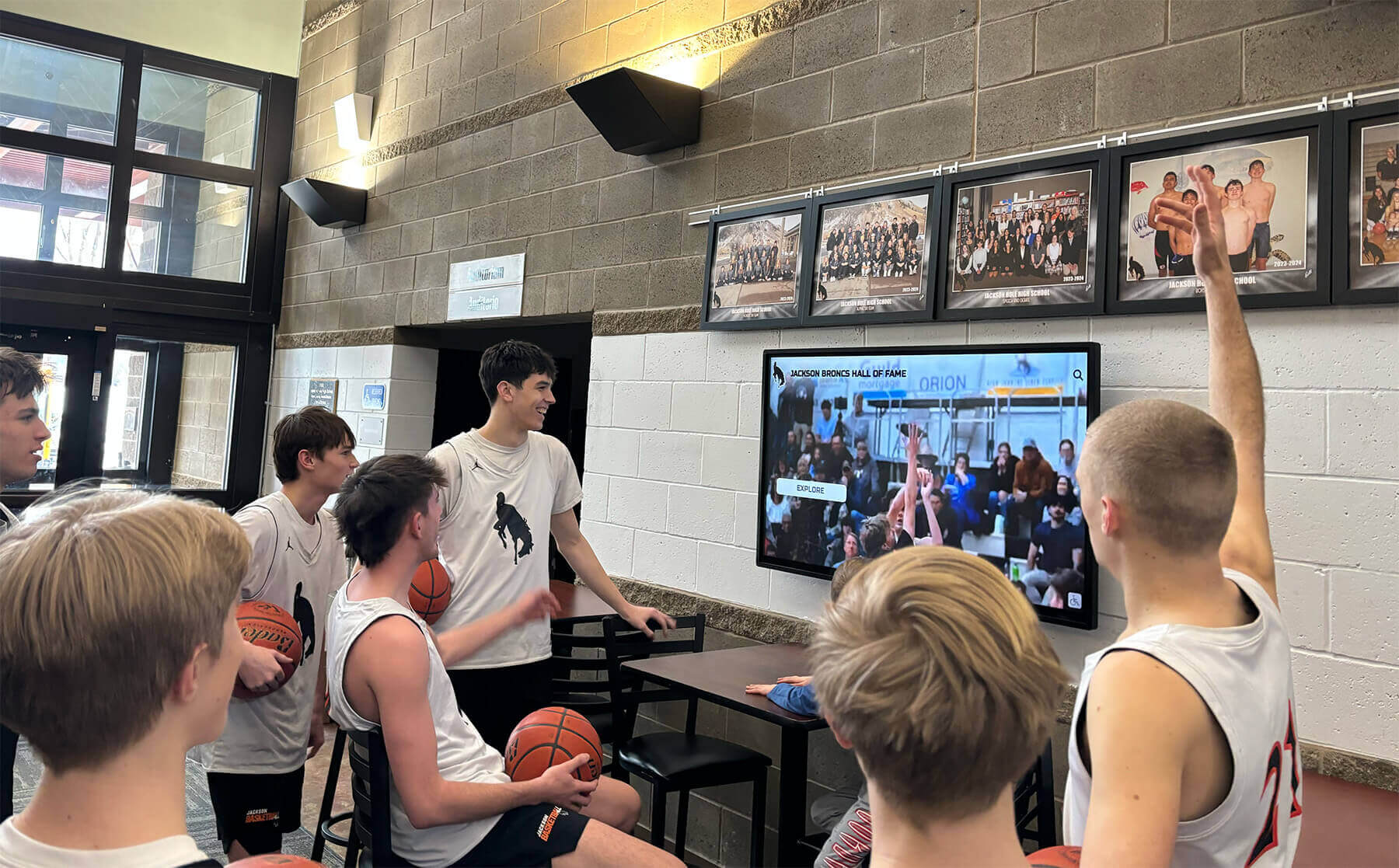
These educational connections transform recognition from passive displays into active teaching resources that deliver ongoing value throughout academic years.
Future-Proofing Your Digital Recognition Investment
Technology evolves rapidly, but thoughtful planning ensures digitized plaque walls remain effective and current for years to come.
Emerging Technology Trends
Organizations planning digitization projects should consider emerging capabilities that may enhance future recognition experiences:
Artificial Intelligence Integration: AI technologies promise automated content enhancement including image quality improvement, text extraction from photographed plaques, intelligent search understanding natural language queries, and personalized content recommendations based on viewing patterns.
Augmented Reality Experiences: AR capabilities will enable enhanced engagement where visitors point smartphones at physical locations to access extended digital content, view historical photos overlaid on current spaces, or explore 3D models of trophies and artifacts.
Voice Interaction: Voice-activated search and navigation making recognition systems accessible to visitors with visual impairments or mobility limitations affecting touchscreen use.
Advanced Analytics: Machine learning analyzing engagement patterns to automatically optimize content presentation, predict what visitors want to see, and surface relevant connections between recognition profiles.
Preservation and Archival Considerations
Digital systems require ongoing attention to preservation ensuring long-term accessibility:
Format Migration: File formats evolve over time. Organizations must periodically migrate content to current standards preventing obsolescence as old formats become unsupported.
Backup Strategies: Implement redundant backup systems storing content in multiple geographic locations protecting against data loss from hardware failures, natural disasters, or security incidents.
Metadata Standards: Use standardized metadata schemas ensuring content remains discoverable and usable even if platforms change over decades.
Platform Independence: When possible, structure content in platform-independent formats enabling migration to different systems if future needs require vendor changes.
Organizations committed to long-term preservation should consider resources about best platforms for building virtual halls of fame ensuring technology choices support sustainability.
Conclusion: Transforming Recognition for the Digital Age
Traditional plaque walls served institutions well for generations, but physical limitations increasingly constrain recognition programs as achievement collections grow. When you digitize plaque wall displays, you eliminate space constraints while simultaneously enhancing recognition quality through searchable databases, rich multimedia content, and interactive exploration impossible with static plaques.
The digitization process requires systematic planning, thoughtful execution, and ongoing commitment to content quality and platform maintenance. Organizations that invest appropriately create recognition systems that honor every achievement, inspire current community members, engage alumni and stakeholders, and preserve institutional memory for future generations.
Whether you’re struggling with overflowing plaque walls, seeking more engaging recognition experiences, or simply wanting to make existing recognition more accessible, digital transformation provides compelling solutions addressing virtually every limitation of traditional approaches while creating new opportunities for connection and inspiration.
The most successful implementations share common characteristics: comprehensive content that tells complete stories rather than just listing names, intuitive interfaces that make exploration enjoyable, strategic placement ensuring visibility and accessibility, and genuine integration into institutional culture and programming.
As you consider digitizing your plaque walls, remember that you’re not just modernizing displays—you’re creating living recognition systems that will evolve and grow alongside your institution, celebrating achievement and inspiring excellence for decades to come.
Ready to Digitize Your Plaque Wall?
Explore how modern digital wall of fame systems can transform your recognition program, or discover comprehensive options for interactive touchscreen displays that honor achievements while building lasting community pride.
For personalized guidance on digitizing your specific plaque walls and creating recognition displays aligned with your institution’s needs and vision, contact Rocket Alumni Solutions to discuss your recognition goals and explore how digital transformation can unlock the full potential of your achievement history.




































